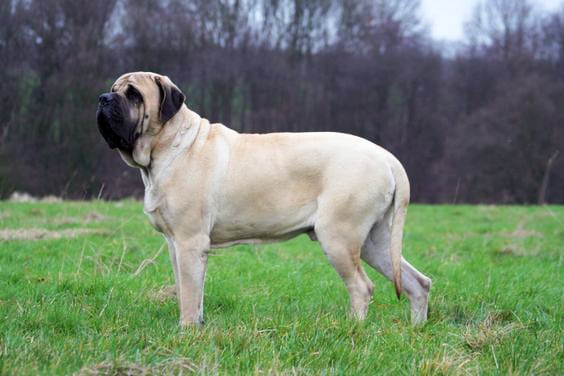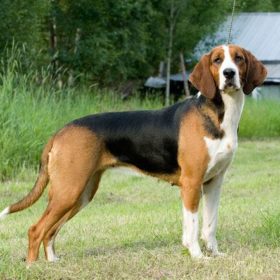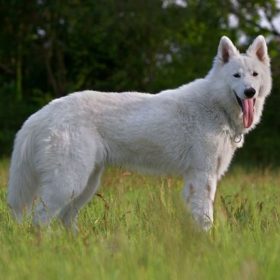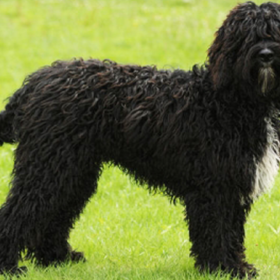English Mastiff

The English Mastiff looks very formidable and intimidating. However, they are excellent, balanced dogs that never show excessive aggression and always listen to their owner. The Mastiff does not like long and active walks. For him, the best pastime is a short walk and rest.
Table of Contents
Breed Information
| Another Name | Mastiff |
| Origin | England |
| Height | 77-79 cm |
| Weight | 70-90 kg |
| Fur | Short, not thinning on the neck, back, shoulder blades |
| Color | Deer, apricot, silvery deer, dark deer, tiger, pale |
| Lifespan | 8-10 years |
| FCI Classification | Pinscher and Schnauzer – Molossoid and Swiss Mountain and Cattledogs |
| Group | Watchdogs, protection dogs (guard dogs) |
| Price | $500-1500 |
Breed Photos
Origin History
The breed’s history is very ancient since it is believed that the English Mastiffs’ ancestors were Tibetan Mastiffs, who inhabited the territory of Babylon, Egypt, Greece, and Persia at that time.
In ancient Rome, dogs participated in gladiatorial fights and were called “mastiffs” there. In Great Britain, dogs were brought by the Saxons, who settled its territories.
In the eleventh century, Mastiffs were used for hunting, and they proved very wise. Also, English Mastiffs guarded and watched over slaves.
The breeding of purebred Mastiffs fell during the Tudor and Stuart reigns. Soon, when England decreed a ban on hounding, the demand for Mastiffs declined sharply, and the species began to disappear. World War I and World War II negatively affected the breed, as there were only 14 English Mastiffs in the world after the war.
Scientists and breeders worked for a long time to restore the breed, using American dogs for this purpose. Fortunately, they succeeded, and now English Mastiffs are famous all over the world.
Appearance
It looks like a large, healthy, harmoniously built dog. The Mastiff’s height at the withers can be 77 to 79 cm; weight ranges from 70 to 90 kg. Bitches are usually smaller than males.
The coat of the English Mastiff is short, thickly undercoated, and shiny. The coat can be apricot, silvery sallow, dark sallow, tiger, pale, and brown. The dog’s muzzle is black.
The dog has brow arches that stand out clearly on the face. There is also a slightly saggy brow around the muzzle.
Character
The English Mastiff looks very formidable and intimidating. However, they are excellent, balanced dogs that never show excessive aggression and always listen to their owner.
The Mastiff does not like long and active walks. For him, the best pastime is a short walk and rest. The English Mastiff gets along well with children, protects them from danger, and always tries to be where they are.
Representatives of the breed are obedient while walking. They do not react aggressively to irritants but walk away from them. For example, he will never bark at other people’s dogs or loud cars. He will walk away from them.
Care
Because English Mastiffs are giant dogs, it would be difficult for them to live in a city apartment because of their size. A mansion is best suited for them.
It is recommended to bathe the dog once every six months or as dirty as possible. The hair of the English Mastiff is not long, but it sheds. Therefore, it is worth daily brushing the pet with a special brush. Systematically it is necessary to check the ears and eyes, and if they are not in good condition, it is required to wipe them with a cotton pad.
Mastiffs can often secrete saliva. Therefore, it is always worth having a dry cloth with you and wipe your pet’s face. It will help avoid the development of bacteria.
Training
The size of the animal can often mislead the owner. A Mastiff that looks grown-up and big can be a puppy that wants to play all the time.
You should train your pet from the first days of its arrival in the house. The most important thing is to teach that you are the master in the house, not him. After all, an English Mastiff can often show leadership.
Praise and encouragement will be useful in training. The English Mastiff loves tenderness and affection from the owner, so you should never yell at them or force them to obey commands.
Experts recommend keeping an exact routine in training. Dogs are more willing to obey in the evening when they know that delicious dinner and sleep are waiting for them. Training should last about an hour.
Common Diseases
The English Mastiff is a dog with good health, but they can have these diseases:
- joint dysplasia;
- leukemia;
- allergy;
- eye diseases.
Nutrition
Feeding an English Mastiff is quite tricky because he eats a lot. There are two feeding options – natural food and food. It is up to the owner to decide how best to feed the pet. An adult dog should be fed twice a day.
 Finnish Hound
Finnish Hound White Swiss Shepherd
White Swiss Shepherd Billy
Billy Barbet
Barbet Sealyham Terrier
Sealyham Terrier Griffon Nivernais
Griffon Nivernais


